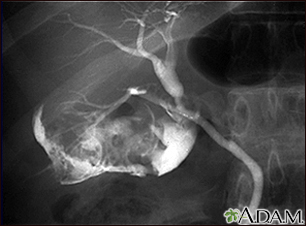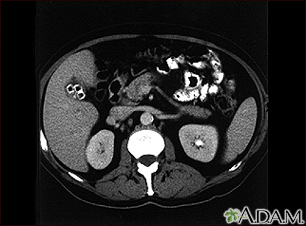Open gallbladder removal
Cholecystectomy - open; Gallbladder - open cholecystectomy; Cholecystitis - open cholecystectomy; Gallstones - open cholecystectomy
Open gallbladder removal is surgery to remove the gallbladder through a large cut in your abdomen.
The gallbladder is an organ that sits below the liver. It stores bile, which your body uses to digest fats in the small intestine.
Images




Presentation

I Would Like to Learn About:
Description
Surgery is done while you are under general anesthesia so you will be asleep and pain-free. To perform the surgery:
- Your surgeon makes a 5 to 7 inch (12.5 to 17.5 centimeters) cut in the upper right part of your belly, just below your ribs.
- The area is opened up so your surgeon can view the gallbladder and separate it from the other organs.
- Your surgeon cuts the bile duct and blood vessels that lead to the gallbladder.
- The gallbladder is gently lifted out and removed from your body.
An x-ray called a cholangiogram may be done during your surgery.
- To do this test, dye is injected into your common bile duct and an x-ray is taken. The dye helps find stones that may be inside the common bile duct.
- If other stones are found, your surgeon will remove them with a special instrument.
The surgery takes about 1 to 2 hours.
Why the Procedure Is Performed
You may need this surgery if you have pain or other symptoms from gallstones. You may also need surgery if your gallbladder is not working normally.
Common symptoms may include:
- Indigestion, including bloating, heartburn, and gas
- Nausea and vomiting
- Pain after eating, usually in the upper right or upper middle area of your belly (epigastric pain)
The most common way to remove the gallbladder is by using a medical instrument called a laparoscope (laparoscopic cholecystectomy). Open gallbladder surgery is used when laparoscopic surgery cannot be done safely. In some cases, the surgeon needs to switch to an open surgery if laparoscopic surgery cannot be successfully continued.
Other reasons for removing the gallbladder by open surgery:
- Unexpected bleeding during the laparoscopic operation
- Obesity
- Inflammation of the pancreas (pancreatitis)
- Pregnancy (third trimester)
- Severe liver problems
- Past surgeries in the same area of your belly
Risks
Risks of anesthesia and surgery in general are:
- Reactions to medicines
- Breathing problems
- Bleeding, blood clots
- Infection
Risks of gallbladder surgery are:
- Damage to the blood vessels that go to the liver
- Injury to the common bile duct
- Injury to the small or large intestine
- Inflammation of the pancreas
Before the Procedure
Your may have the following tests done before surgery:
- Blood tests (complete blood count, electrolytes, liver and kidney tests)
- Chest x-ray or electrocardiogram (ECG), for some people
- Several x-rays of the gallbladder
- Ultrasound of the gallbladder
Tell your surgeon or nurse:
- If you are or might be pregnant
- Which medicines, vitamins, and other supplements you are taking, even ones you bought without a prescription
During the week before surgery:
- You may be asked to stop taking aspirin, ibuprofen (Advil, Motrin), vitamin E, warfarin (Coumadin), and any other medicines that put you at a higher risk of bleeding during surgery.
- Ask your surgeon which medicines you should still take on the day of your surgery.
- Prepare your home for any problems you might have getting around after the surgery.
- You'll be told when to arrive at the hospital.
On the day of surgery:
- Follow instructions about when to stop eating and drinking.
- Take the medicines your surgeon told you to take with a small sip of water.
- Shower the night before or the morning of your surgery.
- Arrive at the hospital on time.
After the Procedure
You may need to stay in the hospital for 3 to 5 days after open gallbladder removal. During that time:
- You may be asked to breathe into a device called an incentive spirometer. This helps keep your lungs working well so that you do not get pneumonia.
- Your nurse will help you sit up in bed, hang your legs over the side, and then stand up and start to walk.
- At first, you will receive fluids into your vein through an intravenous (IV) tube. Soon after, you will be asked to start drinking liquids and eating foods.
- You will be able to shower while you are still in the hospital.
- You may be asked to wear pressure stockings on your legs to help prevent a blood clot from forming.
If there were problems during your surgery, or if you have bleeding, a lot of pain, or a fever, you may need to stay in the hospital longer. Your surgeon or nurses will tell you how to care for yourself after you leave the hospital.
Outlook (Prognosis)
Most people recover quickly and have good results from this procedure.
Related Information
GallstonesAcute cholecystitis
Laparoscopic gallbladder removal
Surgical wound care - open
Bland diet
When you have nausea and vomiting
References
Bonds M, Rocha F. Cholecystectomy techniques and postoperative problems. In: Jarnagin WR, Allen PJ, Chapman WC, et al, eds. Blumgart's Surgery of the Liver, Biliary Tract, and Pancreas. 7th ed. Philadelphia, PA: Elsevier; 2023:chap 36.
Radkani P, Hawksworth J, Fishbein T. Biliary system. In: Townsend CM Jr, Beauchamp RD, Evers BM, Mattox KL, eds. Sabiston Textbook of Surgery. 21st ed. St Louis, MO: Elsevier; 2022:chap 55.
BACK TO TOPReview Date: 9/9/2023
Reviewed By: Debra G. Wechter, MD, FACS, General Surgery Practice Specializing in Breast Cancer, Virginia Mason Medical Center, Seattle, WA. Also reviewed by David C. Dugdale, MD, Medical Director, Brenda Conaway, Editorial Director, and the A.D.A.M. Editorial team.

Health Content Provider
06/01/2025
|
A.D.A.M., Inc. is accredited by URAC, for Health Content Provider (www.urac.org). URAC's accreditation program is an independent audit to verify that A.D.A.M. follows rigorous standards of quality and accountability. A.D.A.M. is among the first to achieve this important distinction for online health information and services. Learn more about A.D.A.M.'s editorial policy, editorial process and privacy policy. A.D.A.M. is also a founding member of Hi-Ethics. This site complied with the HONcode standard for trustworthy health information from 1995 to 2022, after which HON (Health On the Net, a not-for-profit organization that promoted transparent and reliable health information online) was discontinued. |
The information provided herein should not be used during any medical emergency or for the diagnosis or treatment of any medical condition. A licensed medical professional should be consulted for diagnosis and treatment of any and all medical conditions. Links to other sites are provided for information only -- they do not constitute endorsements of those other sites. © 1997- 2025 A.D.A.M., a business unit of Ebix, Inc. Any duplication or distribution of the information contained herein is strictly prohibited.
